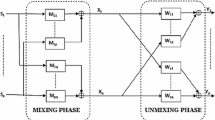Abstract
A new deconvolution method has been presented in this paper. Like conventional Discrete Fourier Transform(DFT) method, it is also a frequency domain method. Since there are only DFT, IDFT and multiplication calculations in the new method, the singular problem appeared in the conventional DFT method can be avoid, and the deconvolution problem can always be solved with the new method. The relationship between the presented method and conventional DFT method is discussed. A numerical example is also presented to illustrate the new method.
Similar content being viewed by others
References
A. V. Oppenheim, et al., Discrete Time Signal Processing. Englewood Chiffs, NJ: Prentice-Hall, Inc. 1989, Chapter 8.
T. K. Sarkar, et al., Impulse response determination in the time domain, IEEE Trans. on AP, AP-30 (1982)4, 657–663.
R. W. Schafer, et al., Constrained iterative deconvolution algorithms, Proc. IEEE, 69(1981)4, 432–450.
F. N. Kong, A new method of deconvolution in the time domain, Acta Electronica Sinica, 13(1985)4, 8–13, (in Chinese).
Author information
Authors and Affiliations
About this article
Cite this article
Yanfei, W. A new method of deconvolution in the frequency domain. J. of Electron.(China) 14, 112–116 (1997). https://doi.org/10.1007/s11767-997-1002-8
Issue Date:
DOI: https://doi.org/10.1007/s11767-997-1002-8




